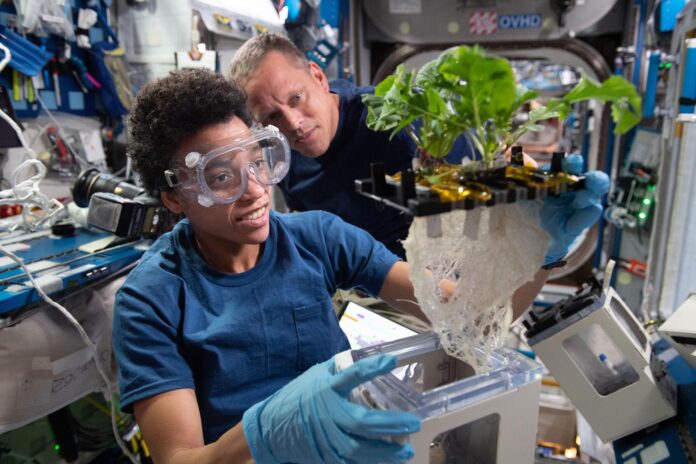Many people ask NASA about what and how the astronauts eat aboard the space shuttle and the space station. The foods they eat are not provided in tubes and they are neither bland nor unsavory. Food systems and menu items have evolved tremendously since the days of the Mercury Program. Here’s a look at how food systems and menu items have evolved, what and how astronauts in space eat now and what future voyagers may eat.
History
The food that NASA’s early astronauts had to eat in space is a testament to their fortitude. John Glenn, America’s first man to eat anything in the near-weightless environment of Earth orbit, found the task of eating fairly easy but found the menu to be limited. Other Mercury astronauts had to endure bite-sized cubes, freeze-dried powders and semi-liquids packaged in aluminum tubes. Most agreed the foods were unappetizing and disliked squeezing the tubes. Moreover, freeze-dried foods were hard to rehydrate and crumbs had to be prevented from fouling instruments.
Eating on the Gemini missions improved somewhat. Bite-sized cubes were coated with gelatin to reduce crumbling, and the freeze-dried foods were encased in a special plastic container
to make reconstituting easier. With improved packaging came improved food quality and menus. Gemini astronauts had such food choices as shrimp cocktail, chicken and vegetables, butter scotch pudding, and applesauce, and were able to select meal combinations themselves.
By the time of the Apollo Program, the quality and variety of food increased even further. Apollo astronauts were the first to have hot water, which made rehydrating foods easier and improved the food’s taste. These astronauts were also the first to use utensils via the “spoon bowl,” a plastic container that could be opened and its contents eaten with a spoon. Thermostabilized pouches were also introduced on Apollo.
The task of eating in space got a big boost in Skylab. Unlike previous space vehicles for astronauts, Skylab featured a large interior area where space was available for a dining room and table. Eating for Skylab’s three-member teams was a fairly normal operation: Footholds allowed them to situate themselves around the table and “sit” to eat. Added to the conventional knife, fork and spoon was a pair of scissors for cutting open plastic seals. Because Skylab was relatively large and had ample storage area, it could feature an extensive menu: 72 different food items. It also had a food freezer and refrigerator – a convenience no other vehicle has offered, before or since.
Space Shuttle Food System
The kinds of foods crewmembers eat aboard the space shuttle are not mysterious concoctions, but foods prepared here on Earth. Many are commercially available on grocery store shelves. Astronauts select their menus from a large array of food items. Diets are designed to supply each astronaut with 100 percent of the daily value of vitamins and minerals necessary for the environment of space.
Foods flown on space missions are researched and developed at the Space Food Systems Laboratory at the Johnson Space Center (JSC) in Houston, which is staffed by food scientists, dietitians and engineers. Foods are analyzed through nutritional analysis, sensory evaluation, storage studies, packaging evaluations and many other methods.
Food evaluations are conducted with shuttle flight crews about eight to nine months before the scheduled launch date. During the food evaluation sessions, the astronaut samples a variety of foods and beverages available for flight. Crewmembers choose their menus and can repeat days or not repeat days at their discretion. They plan breakfast, lunch and dinner; snacks are listed with the meals. Types of food available include rehydratable, thermostabilized, irradiated and natural form items.
Rehydratable items include both foods and beverages. One way weight can be conserved during the launch is to remove water from certain food items. During the flight, water generated by the shuttle fuel cells is added back to the food just before it is eaten.
Foods packaged in rehydratable containers include soups like chicken consommé and cream of mushroom, casseroles like macaroni and cheese and chicken and rice, appetizers like shrimp cocktail, and breakfast foods like scrambled eggs and cereals. Breakfast cereals are prepared by packaging the cereal in a rehydratable package with nonfat dry milk and sugar, if needed. Water is added to the package just before the cereal is eaten.
The rehydratable food package is made from flexible material to aid in trash compression. It consists of a flexible bowl and lid with a septum adapter for adding water from the galley. Velcro on the bottom of the package holds it in the meal tray. After adding the required amount of water to the package, it is placed in the oven if the food is to be served hot or directly onto the serving tray if the food is to be served cold. The top of the package is cut off with a knife or scissors, and the contents are eaten with a fork or spoon.
Thermostabilized foods are heat processed to destroy harmful microorganisms and enzymes. Individual servings of thermostabilized foods are commercially available in aluminum or bimetallic cans, plastic cups, or flexible retort pouches. Most of the fruits and fish such as tuna and salmon are thermostabilized in cans. The cans open with easy-open, full-panel, pullout lids. Puddings are packaged in plastic cups. Most of the entrees are packaged in flexible retort pouches. This includes products such as beef tips with mushrooms, tomatoes and eggplant, chicken à la king, and ham. After the pouches are heated, they are cut open with scissors. The food is eaten directly from the containers with conventional eating utensils.
Some irradiated meat items are also available for space shuttle crews. These products are very similar to thermostabilized foods in that they are ready to eat and only require warming prior to consumption. These items are packaged in flexible pouches.
Foods such as nuts, granola bars and cookies are classified as natural form foods. They are ready to eat, are packaged in clear, flexible pouches that are cut open with scissors, and require no further preparation for consumption in flight.
Condiments include commercially packaged individual pouches of catsup, mustard, mayonnaise, taco sauce and hot pepper sauce. Polyethylene dropper bottles contain bulk supplies of liquid pepper and liquid salt. The pepper is suspended in oil and the salt is dissolved in water.
Flour tortillas are a favorite bread item of shuttle astronauts. Tortillas provide an easy and acceptable solution to the breadcrumb and microgravity-handling problem, and have been used since 1985.
Beverages come in powdered form and include coffee, tea, apple cider, orange juice and lemonade. The beverage package is made from a foil laminate to provide maximum barrier properties for a longer product shelf life. A septum adapter is sealed in the package after the beverage powder has been added. The septum adapter holds a septum that interfaces with the galley water dispenser for the addition of water and with a straw for drinking the beverage.
Foods are individually packaged and stowed for easy handling in microgravity. All food is precooked or processed so it requires no refrigeration and is either ready to eat or can be prepared simply by adding water or by heating. The only exceptions are the fresh fruit and vegetables. Without refrigeration, the fresh foods must be eaten within the first few days of the flight or they will spoil.
Once astronauts select their menu, about five months before the flight, the menus are analyzed for nutritional content and recommendations are made to correct any nutrient deficiencies. The menus are then finalized and provided to the shuttle food contractor in Houston three months before launch. Food is packaged and stowed in the locker trays at JSC about a month before each launch. Stowed food lockers and shipping containers are kept under refrigeration.
About three weeks before launch, the food lockers are shipped to Kennedy Space Center (KSC) in Florida. There they are refrigerated until they are installed in the shuttle two to three days before launch. Besides the meal and pantry food lockers, a fresh food locker is packed at KSC and installed on the shuttle 24 to 36 hours before launch. The fresh food locker contains items such as tortillas, bread, breakfast rolls, and fruits and vegetables such as apples, bananas, oranges, and carrot and celery sticks.
Meals are stowed aboard the orbiter in locker trays with food packages arranged in the order in which they will be used. A label on the front of the locker tray lists the locker contents. A five-section net restraint keeps food packages from floating out of the locker while still allowing items inside to be seen.
Astronauts are supplied with three balanced meals, plus snacks. Each astronaut’s food is stored aboard the space shuttle and is identified by a colored dot affixed to each package. A supplementary food supply (pantry) consisting of two extra days per person is stowed aboard the space shuttle for each flight. Pantry items are flown in addition to the menu in case the flight is unexpectedly extended because of bad weather at the landing site or for some other unforeseen reason. During the flight, this food supply provides extra beverages and snacks.
Dining Aboard the Space Shuttle
Meals in space consist of familiar, appetizing, well-accepted food items that can be prepared quickly and easily. A full meal for a crew of four can be set up in about five minutes. Reconstituting and heating the food takes an additional 20 to 30 minutes – about the time it takes to fix a snack at home and far less than it takes to cook a complete meal.
On the space shuttle, food is prepared at a galley installed on the orbiter’s mid-deck. The galley is a modular unit that contains a water dispenser and an oven. The water dispenser is used for rehydrating foods and beverages, and the galley oven is used for warming foods to the proper serving temperature.
Discover more from SNAP TASTE
Subscribe to get the latest posts to your email.


